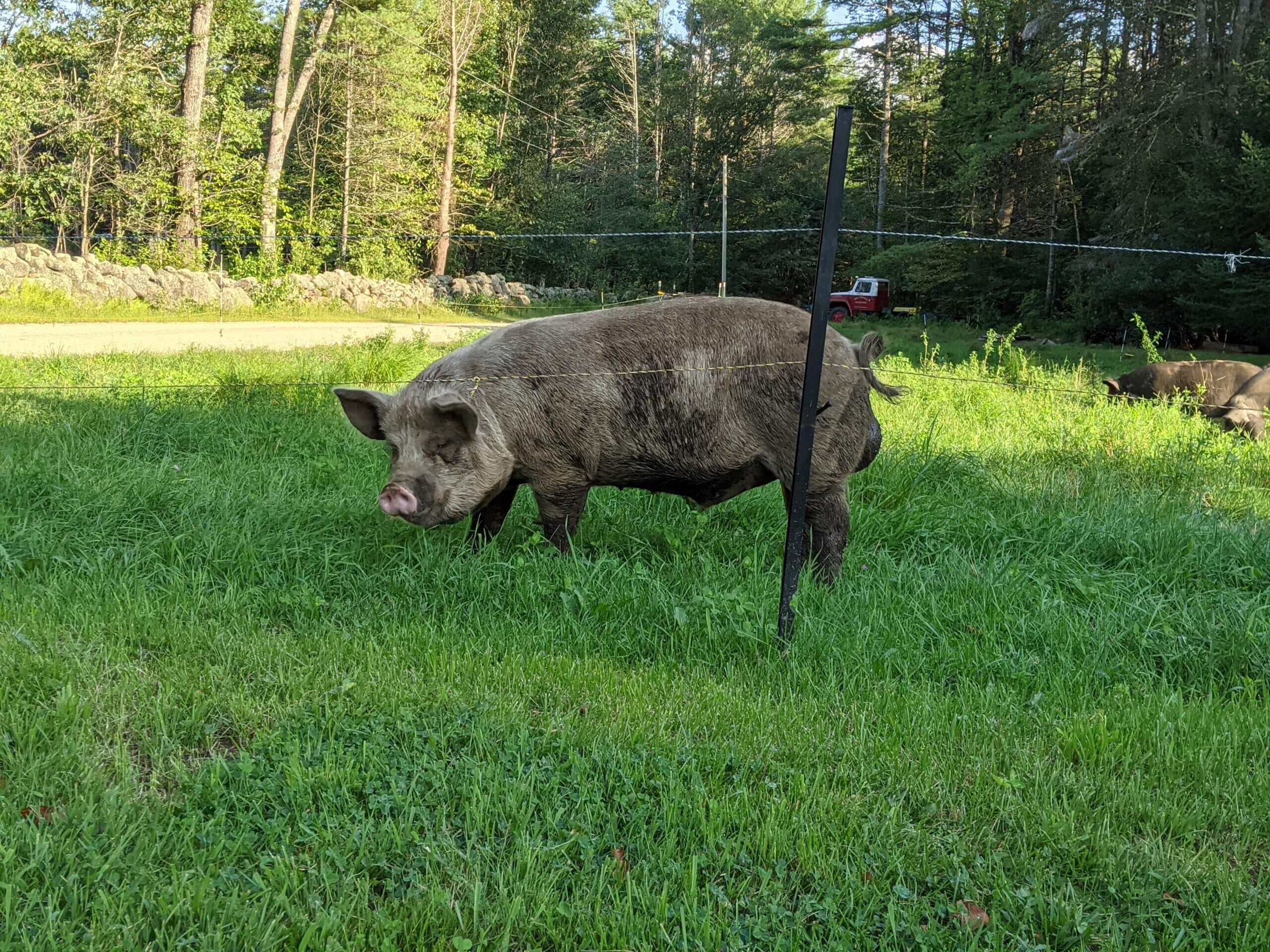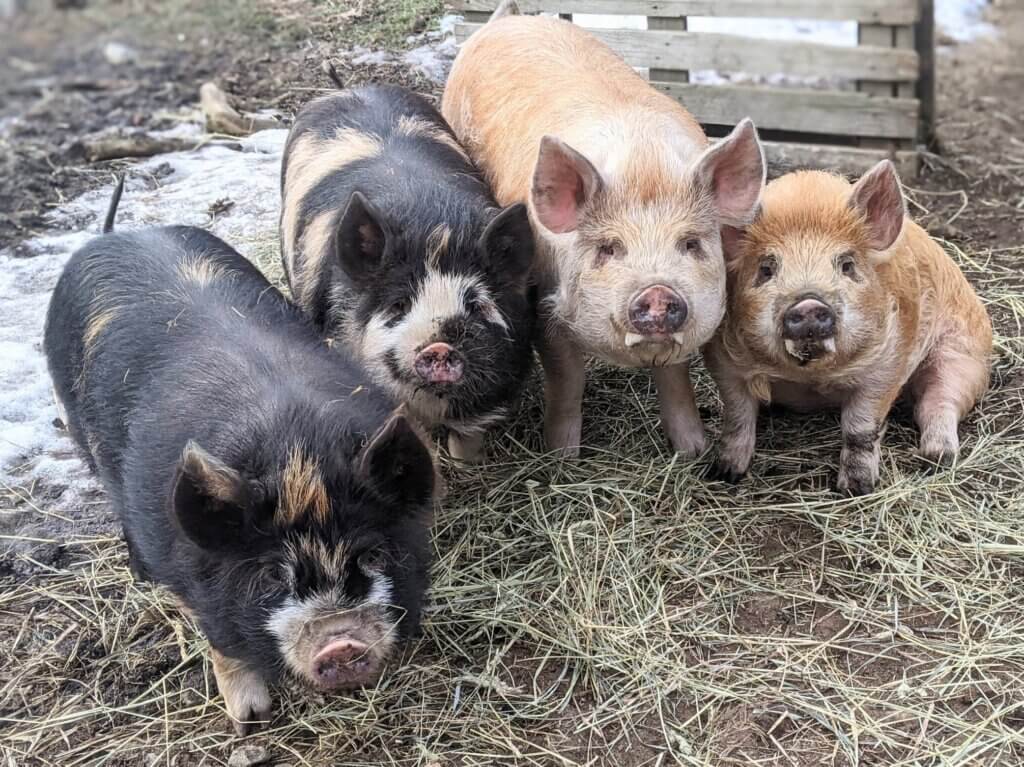At Courser Meadows we choose to raise Idaho Pasture Pigs for a variety of reasons:
- They are great for grass-based farms like ours, because of their shorter, upturned snout, they actually graze on grass instead of rooting up pastures. As well as this being better for farms that depend on their pastures and don't want them ruined, it also saves on grain costs as IPP's supplement their diet with grass and hay, AND it makes for a healthier (higher in omega 3's), tastier, and more marbled meat.
- They make excellent, docile mothers and have vigorous, well growing piglets.
- Both boars and sows have excellent temperaments, and as the mature weight for boars is 300-400lbs, and 250-300 for sows, it makes having breeding pairs more feasible to care for year round as their overall consumption will be far lower than larger traditional breeds.
- Reach market weight (200-250lbs.) and ready for processing at 8-10 months.
In addition to raising pork for our customers at Courser Meadows, we also have unrelated breeding pairs that we sell feeder pigs and registered breeding stock from.
Our Current Breeding Stock
Our Breeding Sows at Courser Meadows
Matilda
Matilda (Fate line - DOB 01/02/17) is a wonderful tri-color sow that we picked up in Ohio. She is a robustly built pig and has very consistent litters. Litters: Tilly X Ferdinand 02/20/18 - 7 Piglets Tilly X Hamilton 09/24/18 - 11 Piglets Tilly X Hamilton 05/15/19 - 9 Piglets Tilly X Pumba 03/30/20 - 11 Piglets Tilly X Pumba 03/18/21 - 9 Piglets Tilly X Pumba 09/17/21 - 9 Piglets Tilly's next litter is sired by Pumba and is expected in March 2022.Maisel
Maisel (Destiny line – DOB 03/26/18) is a super sweet tri-color sow we got as an adult from VT. She has a very relaxed demeanor and is a great mother and has had very consistent litters for us. Litters: Maisel X Merlin 08/09/19 - 6 Piglets Maisel X Merlin 03/09/20 - 8 Piglets Maisel X Merlin 09/09/20 - 9 Piglets Maisel X Merlin 03/18/21 - 7 Piglets Maisel X Pumba 09/04/21 - 9 Piglets Maisel's next litter is sired by Stilwell and is expected in March 2022.Gertie
Gertie (Heart line – DOB 09/18/20) is a tri-color gilt we got from White Bison Farm in Wisconsin to add additional lines to our farm. She farrowed her first litter during the Fall of 2021. Litters: Gertie X Stilwell 09/15/21 - 6 Piglets Gertie's next litter is sired by Stilwell and is expected in March 2022.Gladys
Gladys (Diana line – DOB 09/23/20) is a tri-color gilt we got from White Bison Farm in Wisconsin to add additional lines to our farm. She farrowed her first litter during the Fall of 2021. Litters: Gladys X Stilwell 09/28/21 - 10 Piglets Gladys' next litter is sired by Pumba and is expected in March/April 2022.Our Boars at Courser Meadows
Pumba
Pumba (Bandit line – DOB 10/28/17) is a wonderful tri-color boar we were lucky to get from Mouse Creek Farm in PA. He is a fantastically built boar with a great body and nice wide face with a short upturned nose. He has had some wonderful litters on the farm and we look forward to seeing his future litters. He has sired 9 litters so far (a litter of 7, 6, 5, 10, 11, 7, 9, 9, and 9) and his next two are due in the Spring of 2022.Stilwell
Stilwell (Rex line – DOB 11/11/20) is a young ginger boar we brought to our farm from NY. He is maturing nicely, and the first two litters he sired were born in the fall of 2021. We are expecting three litters from him during the Spring of 2022.Fall 2022 & Spring 2023 Prices: Check our For Sale page for more info or to reserve your piglets!
Tips for successfully raising IPP's

Wallows
All pigs must have a wallow in warm weather, this is the only way for them to stay cool. Pigs don't sweat so a wallow to cool down in is a necessity for their comfort and wellbeing. When pigs are on pasture they will either create their own wallow as needed (which might not be where you you want it!) or you can create one for them on the edge of the pasture, preferably where rain water might collect or in a spot you can add water periodically to keep them cool. We try to create ours on the edge of the forest (but within reach of a hose) where grass isn't growing anyways so we are not wasting good grazing! Also, if possible, it's best to place them in a shaded area. The younger, smaller piggies won't say no to a kiddie pool either in hot weather!Rotational Grazing
Moving the pigs around to fresh pasture is the best way to utilize nutrients and also to keep your pastures from being overgrazed, as well as helping to control parasites. If your farm only has a small amount of pasture or you are raising pigs during a drought year we have found the best way to keep pastures from becoming over grazed is to have the pigs' main living area fenced in the woods and then to have different gates (fencing and gates on our farm consists of one or two low strands of electric poly or metal wire – super easy to put up and take down and fence in large areas) that allow access to grassy areas when there is enough grass. Ideally, pigs will get to graze everyday, but that depends on pasture size/quality and whether it may be necessary to keep them off it to let the grass "bounce" back. If this happens it is good to supplement your pigs daily ration with some hay, as they will readily eat it to replace the grass portion of their diet. Pasture quality varies, so it's hard to say how much area pigs need to graze, but the generally accepted standard is whatever amount of grass will keep one cow will typically feed 10 IPP's. And a general rule of thumb is one acre for 1 cow, thus 10 IPP's.Fencing
The majority of our pigs are raised on one or two low strands of either electric metal or poly wire, as it is easy to move around and inexpensive to fence in large areas. Younger piglets need to be trained to properly respect this, so they are started on either livestock fencing with an interior strand of electric fencing, or with electric pig netting, as both have a barrier that teach the pig to jump backwards when “zapped” by the fence, instead of charging through it, as they may do with just strands of wire.
Housing
During the summer, pigs do well with A-frame type housing, hoop houses made with cattle or hog panels, calf hutches, or other enclosures that give protections from sun and inclement weather, preferably open on both ends for air flow in hot weather. We stuff pig houses with hay for extra comfort and to stay dry when raining. Similar housing can be used during the winter (at least 3-sided) or barn stalls work well too. In winter we always make sure houses are filled really well with dry hay to keep piggies warm and insulated. We check the bedding regularly to be sure it's still dry, and add more as needed. We also hang an old piece of carpet in their doorways so they can push through it to go in and out at will, but the carpet acts as a barrier to cold and wind.Feeding
In addition to grazing on the grass in the summer or hay supplement in the winter (~1-2 flakes per pig per day), adult breeding stock get 2-3lbs (1-1.5lbs morning and evening) of grain daily during the summer months, and 3-4lbs/day in the winter months (ours get Green Mountain Organic for feeder piglets, Poulin Pig Grower for breeding stock). As a supplement we add 1Tablespoon/100# body weight of organic kelp top dressed to feed. Piggies also never say no to fresh veggies, raw milk, boiled eggs, or drop apples!
Our feeder piglets that we're raising for meat get a slightly incremental diet as they grow. In addition to continual access to grass or hay, they receive free choice pellets until they're weaned at 5 or 6 weeks of age, and then they each get approximately 1 lb per day (1/2 lb morning & night) until they're 2 months old. We then increase their food to two pounds per day. At 4 months it goes up to 3 pounds/day, and about 6 months of age, we up their ration to 3.5lbs/day, and at 7 months we increase it to 4lbs/day. We always split the amounts into two feedings - half in the morning and half in the evening. And then we typically have them processed at 8 months of age.
And let's not forgot the most important part of a pig's diet (or anyone's for that matter:-) - water! They need to have access at all times. There are many different options for watering systems (just google it and you'll find many!). We use rubber tubs, and have good luck w/them, although sometimes we need to secure them in place so they don't get tipped over or we build heavy wooden boxes that can't be flipped over that we place the tubs into. We haven't had good luck w/de-icing systems so we fill our water tubs at least three times a day on winter days to be sure the pigs have water available, even in freezing temperatures.







































